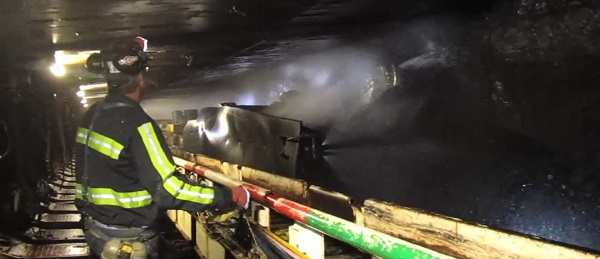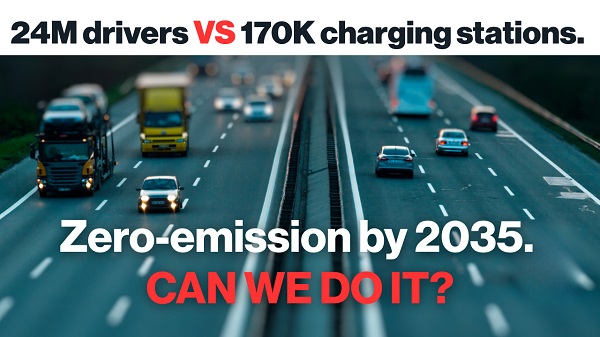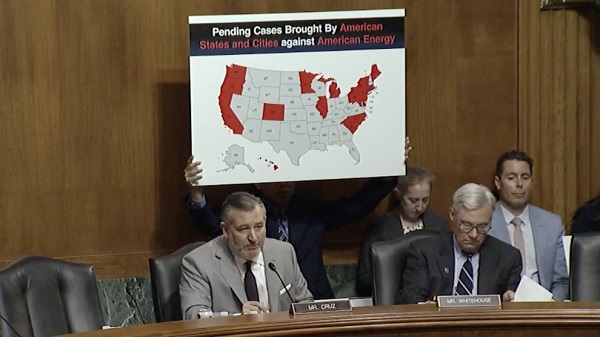Energy
Dig, Baby, Dig: Making Coal Great Again. A Convincing Case for Coal


From the Daily Caller News Foundation
By Gordon Tomb
Has the time come to make coal great again? Maybe.
“Coal is cheap and far less profitable to export than to burn domestically. so, let’s burn it here,” says Steve Milloy, a veteran observer of the energy industry who served on the Environmental Protection Agency (EPA) transition team for the first Trump administration. “It will provide an abundance of affordable and reliable electricity while helping coal communities thrive for the long term.”
The U.S. coal industry has been in a long decline since at least President Barack Obama’s regulatory “war on coal” initiated 15 years ago. At the same time, natural gas became more competitive with coal as a power-plant fuel when new hydrofracturing techniques lowered the price of the former.
In Pennsylvania, a state with prodigious amounts of both fuels, natural gas has all but replaced coal for electric generation. Between 2001 and 2021, gas’ share of power production rose from 2% to 52% as coal’s dropped from 57% to 12%, according to the U.S. Energy Information Administration. Last year, Pennsylvania’s largest coal-fired power plant shut down under the pressures of regulations and economics after spending nearly $1 billion on pollution controls in the preceding decade.
Nationally, between 2013 and 2023, domestic coal production declined by more than 30% and industry employment by more than 40%.
While the first Trump administration provided somewhat of a respite from federal hostility toward fossil fuels in general and coal in particular, President Joe Biden revived Obama’s viciously negative stance on hydrocarbons while promoting weather-dependent wind and solar energy. This absurdity has wrecked livelihoods and made the power grid more prone to blackouts.
Fortunately, the second Trump administration will be exponentially more friendly toward development of fossil fuels. High on the list is increasing exports of liquefied natural gas (LNG). “[T]he next four years could prime the liquefied natural gas (LNG) markets for a golden era,” says market analyst Rystad Energy. “[T]he returning president’s expected policies are likely to accelerate U.S. LNG infrastructure expansion through deregulation and faster permitting…”
All of which is in line with Milloy’s formulation of energy policy. We should “export our gas to Europe and Asia, places that will pay six times more than it sells for in the U.S.” says Milloy, publisher of JunkScience.com and author of books on regulatory overreach, fearmongering and corruption. “Let’s reopen mothballed coal plants, build new coal plants…”
Accompanying rising expectations of easing regulatory obstacles for natural gas is hope that coal can clear daunting environmental hurdles put in place by “green” zealots.
For one thing, the obnoxiously irrational EPA rule defining carbon dioxide — a byproduct of combustion — as a pollutant is destined for the dustbin of destructive policy as common sense and honest science are reestablished among regulators.
Moreover, clean-coal technology makes the burning of the fuel, well, clean. China and India have more than 100 ultra-super critical coal-fired plants that employ high pressures and temperatures to achieve extraordinary efficiencies and minimal pollution. Yet, the United States, which originated the technology more than a decade ago, has only one such facility — the John W. Turk plant in Arkansas.
The point is the United States is underutilizing both coal and the best technology for its use. At the current rate of consumption, the nation’s 250 billion tons of recoverable coal is enough for more than 200 years.
So, if more natural gas winds up being exported as LNG at higher prices, might not coal be an economical — and logical — alternative?
Nuclear power is another possibility, but not for a while. Even with a crash development program and political will aplenty, it is likely to take decades for nuclear reactors to be deployed sufficiently to carry the bulk of the nation’s power load. Barriers range from the need to sort out competing nuclear technologies to regulatory lethargy —if not misfeasance — to financing needs in the many billions and a dearth of qualified engineers.
The last big U.S. reactors to go into operation — units 3 and 4 of Georgia Power’s Vogtle plant — took more than a decade to build and went $17 billion over budget.
“The regulatory environment is better, but it still costs too much and takes too long to get new reactors approved,” writes long-time nuclear enthusiast Robert Bryce.
Can anybody say, “Dig, baby, dig?”
Gordon Tomb is a senior advisor with the CO2 Coalition, Fairfax, Virginia, and once drove coal trucks.
Energy
B.C. Residents File Competition Bureau Complaint Against David Suzuki Foundation for Use of False Imagery in Anti-Energy Campaigns

From Energy Now and The Canadian Newswire
A group of eight residents of Northeast British Columbia have filed a formal application for inquiry with Canada’s Competition Bureau, calling for an investigation into the David Suzuki Foundation’s (the Foundation) use of false and misleading imagery in its anti-energy campaigns.
The complaint alleges that the Foundation has repeatedly used a two-decade-old aerial photograph of Wyoming gas wells to falsely depict modern natural gas development in B.C.’s Montney Formation. This area produces roughly half of Canada’s natural gas.
Key Facts:
- The misleading image has been used on the Foundation’s website, social media pages, reports and donation appeals.
- The Foundation has acknowledged the image’s true source (Wyoming) in some contexts but has continued to use it to represent B.C. development.
- The residents claim this materially misleads donors and the public, violating Section 74.01(1) of the Competition Act.
- The complaint is filed under Sections 9 and 10 of the Act, asking the Bureau to investigate and impose remedies including ceasing the conduct, publishing corrective notices, and returning proceeds.
Quote from Deena Del Giusto, Spokesperson:
“This is about fairness and truth. The people of Northeast B.C. are proud of the work they do to produce energy for Canada and the world. They deserve honest debate, not scare tactics and misleading imagery used to raise millions in donations. We’re asking the Competition Bureau to hold the David Suzuki Foundation to the same standard businesses face: tell the truth.”
Background:
Natural gas development in the Montney Formation supports thousands of jobs and fuels economic activity across the region. Accurate public information is vital to informed debate, especially as many Canadians live far from production sites.
SOURCE Deena Del Giusto
Economy
Trump opens door to Iranian oil exports

This article supplied by Troy Media.
U.S. President Donald Trump’s chaotic foreign policy is unravelling years of pressure on Iran and fuelling a surge of Iranian oil into global markets. His recent pivot to allow China to buy Iranian crude, despite previously trying to crush those exports, marks a sharp shift from strategic pressure to transactional diplomacy.
This unpredictability isn’t just confusing allies—it’s transforming global oil flows. One day, Trump vetoes an Israeli plan to assassinate Iran’s supreme leader, Ayatollah Khamenei. Days later, he calls for Iran’s unconditional surrender. After announcing a ceasefire between Iran, Israel and the United States, Trump praises both sides then lashes out at them the next day.
The biggest shock came when Trump posted on Truth Social that “China can now continue to purchase Oil from Iran. Hopefully, they will be purchasing plenty from the U.S., also.” The statement reversed the “maximum pressure” campaign he reinstated in February, which aimed to drive Iran’s oil exports to zero. The campaign reimposes sanctions on Tehran, threatening penalties on any country or company buying Iranian crude,
with the goal of crippling Iran’s economy and nuclear ambitions.
This wasn’t foreign policy—it was deal-making. Trump is brokering calm in the Middle East not for strategy, but to boost American oil sales to China. And in the process, he’s giving Iran room to move.
The effects of this shift in U.S. policy are already visible in trade data. Chinese imports of Iranian crude hit record levels in June. Ship-tracking firm Vortexa reported more than 1.8 million barrels per day imported between June 1 and 20. Kpler data, covering June 1 to 27, showed a 1.46 million bpd average, nearly 500,000 more than in May.
Much of the supply came from discounted May loadings destined for China’s independent refineries—the so-called “teapots”—stocking up ahead of peak summer demand. After hostilities broke out between Iran and Israel on June 12, Iran ramped up exports even further, increasing daily crude shipments by 44 per cent within a week.
Iran is under heavy U.S. sanctions, and its oil is typically sold at a discount, especially to China, the world’s largest oil importer. These discounted barrels undercut other exporters, including U.S. allies and global producers like Canada, reducing global prices and shifting power dynamics in the energy market.
All of this happened with full knowledge of the U.S. administration. Analysts now expect Iranian crude to continue flowing freely, as long as Trump sees strategic or economic value in it—though that position could reverse without warning.
Complicating matters is progress toward a U.S.-China trade deal. Commerce Secretary Howard Lutnick told reporters that an agreement reached in May has now been finalized. China later confirmed the understanding. Trump’s oil concession may be part of that broader détente, but it comes at the cost of any consistent pressure on Iran.
Meanwhile, despite Trump’s claims of obliterating Iran’s nuclear program, early reports suggest U.S. strikes merely delayed Tehran’s capabilities by a few months. The public posture of strength contrasts with a quieter reality: Iranian oil is once again flooding global markets.
With OPEC+ also boosting output monthly, there is no shortage of crude on the horizon. In fact, oversupply may once again define the market—and Trump’s erratic diplomacy is helping drive it.
For Canadian producers, especially in Alberta, the return of cheap Iranian oil can mean downward pressure on global prices and stiffer competition in key markets. And with global energy supply increasingly shaped by impulsive political decisions, Canada’s energy sector remains vulnerable to forces far beyond its borders.
This is the new reality: unpredictability at the top is shaping the oil market more than any cartel or conflict. And for now, Iran is winning.
Toronto-based Rashid Husain Syed is a highly regarded analyst specializing in energy and politics, particularly in the Middle East. In addition to his contributions to local and international newspapers, Rashid frequently lends his expertise as a speaker at global conferences. Organizations such as the Department of Energy in Washington and the International Energy Agency in Paris have sought his insights on global energy matters.
Troy Media empowers Canadian community news outlets by providing independent, insightful analysis and commentary. Our mission is to support local media in helping Canadians stay informed and engaged by delivering reliable content that strengthens community connections and deepens understanding across the country.
-

 Agriculture2 days ago
Agriculture2 days agoCanada’s supply management system is failing consumers
-

 Alberta1 day ago
Alberta1 day agoCOVID mandates protester in Canada released on bail after over 2 years in jail
-

 armed forces23 hours ago
armed forces23 hours agoCanada’s Military Can’t Be Fixed With Cash Alone
-

 International1 day ago
International1 day agoTrump transportation secretary tells governors to remove ‘rainbow crosswalks’
-

 Business1 day ago
Business1 day agoCarney’s spending makes Trudeau look like a cheapskate
-

 Business24 hours ago
Business24 hours agoCanada’s loyalty to globalism is bleeding our economy dry
-

 Alberta23 hours ago
Alberta23 hours agoAlberta Next: Alberta Pension Plan
-

 Economy2 days ago
Economy2 days agoTrump opens door to Iranian oil exports









